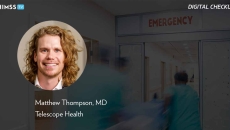Clinical
Patients in the largely rural pediatric population now have a better office experience and more personalized treatment with artificial intelligence, says VCH's physician informatics director.
Do provider organizations have contract protections against supply chain rate hikes due to tariffs? Ralph Keiser, CEO of ArcheHealth, digs into the details.
AI & ML Intelligence
Nearly seven in 10 hospitals were using predictive artificial intelligence in 2024, with a surge in the use of third-party or self-developed automated billing, the agency says. Also, hospitals slower to adopt AI are lower-resourced, suggesting a divide.
Pelu Tran, Ferrum Health's CEO, says a point solution approach for scaling health AI "doesn't really work when you're dealing with every possible disease, patient or service line" needing AI, and favoring one LLM may also limit future coding.
Collaborating on identity verification tech is making it possible for patients to go to TEFCA and get their records, says HealthEx CEO Dr. Priyanka Agarwal. She also weighed in on what's needed to rapidly scale Individual Access Services.
Using virtual care, clinicians can conduct follow-up appointments - transitional care when there's the risk of readmission - that benefit patients, says Dr. Matthew Thompson, an ER physician and the CEO of Telescope Health.
Success Stories & ROI
The St. Louis-based health system achieved a 15%-20% increase in diabetic retinopathy screening. And individuals in lower socioeconomic groups were more than 2.5 times as likely to be screened as a result of using the technology.
Dr. Mark Sendak, pop health & data science lead at the Duke Institute for Health Innovation, offers an update on the Health AI Partnership, and how it's offering technical assistance to help FQHCs and community hospitals bridge the digital divide.
Richard Staynings, chief security strategist at Cylera, says hospitals need better visibility into the various AI-enabled tools coming onto their networks, and the ability to track new traffic patterns, security vulnerabilities and privacy risks.
Reaching this stage enables safer care with fewer errors, faster diagnostics, optimised operations, and stronger patient engagement.









